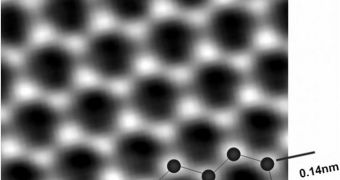Graphene is widely believed to be the material of choice for tomorrow's electronic devices, with the sole factor that could get in the way being the fact that current production methods do not allow for its production on a large scale. But a group of experts announces the development of a new production method for the amazing carbon compound, which could see it being used in a wide variety of technological processes, Technology Review reports.
At this point, graphene production methods are fairly primitive. Experts simply chip away at large graphite blocks, and then browse through what is left, searching for single-layered flakes that might have been formed. Needless to say, this technique is extremely cost intensive and inefficient, so researchers have been looking for a way to replace it for a long time. At the current graphene production rate, it's highly unlikely that the market will ever be able to benefit from its amazing physical and chemical properties.
In a new study, Japanese experts from the Tohoku University, led by scientist Hirokazu Fukidome, report the development of an approach that could see graphene being produced via a silicone substrate. In the proof-of-concept they created, the investigators used this new technology in combination with a process known as litography, which is currently widely employed by transistor and processor manufacturers around the world. The end-result was a graphene-on-silicon field effect transistor, which is a structure that the electronics industry wants to replicate billions and billions of times.
The breakthrough is very likely to lead to the widespread “adoption” of graphene by the industry. Some have expressed concerns that this is not very likely to happen in the foreseeable future, on account of the fact that all major companies have invested considerable amounts of money in silicon-based technologies. But the hybrid transistor alleviates these worries, and open the way for the two types of systems to be combined. This means that, at least in theory, the new devices will be compliant with the vast majority of existing, silicon-based technologies.

 14 DAY TRIAL //
14 DAY TRIAL //